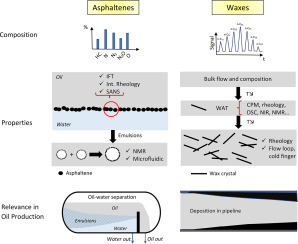当前位置:
X-MOL 学术
›
Adv. Colloid Interface Sci.
›
论文详情
Our official English website, www.x-mol.net, welcomes your
feedback! (Note: you will need to create a separate account there.)
A critical update of experimental techniques of bulk and interfacial components for fluid characterization with relevance to well fluid processing and transport.
Advances in Colloid and Interface Science ( IF 15.9 ) Pub Date : 2020-02-04 , DOI: 10.1016/j.cis.2020.102120 Sébastien Simon 1 , Jost Ruwoldt 1 , Johan Sjöblom 1
Advances in Colloid and Interface Science ( IF 15.9 ) Pub Date : 2020-02-04 , DOI: 10.1016/j.cis.2020.102120 Sébastien Simon 1 , Jost Ruwoldt 1 , Johan Sjöblom 1
Affiliation

|
The present article reviews techniques to address central flow assurance and separation issues. It is our purpose to update the need for extended information in order to draw adequate conclusions about the reason for irregularities in production and how this is related to individual components or fractions in the crude oil. Our intention is to show that the mass related analysis (such as SARA, MS etc.) are insufficient for a validation of the early stage predictions concerning irregularities. The review introduces a set of new characterization and fractionation techniques such as interfacial rheology, SANS, and NMR, where the central theme is the functionality of the components and not just their mass. Two crude oil-related issues are addressed: Wax precipitation and deposition, and crude oil/water resolution. First, bulk techniques to characterize wax precipitation are reviewed. The influence of the chemistry of other crude oil components (asphaltenes) and wax inhibitor on the precipitation is highlighted. Secondly, in aqueous systems, interfacial w/o conditions are important for the stability of dispersed systems. Asphaltenes have a crucial and important role in the stability of crude oil emulsions. Here special attention is directed to properties like interfacial viscosity and elasticity as well as the adsorbed layer structure determination. Small molecular changes in these properties will have dramatic influence on the stability of the heterogeneous systems. A good example is inhibitor functionality.
中文翻译:

与流体处理和运输有关的,用于表征流体的块状和界面成分实验技术的重要更新。
本文介绍了解决中央流量保证和分离问题的技术。我们的目的是更新对扩展信息的需求,以便就生产中不规则的原因以及与原油中各个成分或馏分的关系得出充分的结论。我们的意图是表明,与质量相关的分析(例如SARA,MS等)不足以验证有关不规则现象的早期预测。这篇综述介绍了一组新的表征和分级分离技术,例如界面流变学,SANS和NMR,其中的中心主题是组分的功能,而不仅仅是其质量。解决了两个与原油有关的问题:蜡的沉淀和沉积以及原油/水的分离度。第一,综述了表征蜡沉淀的大量技术。突出了其他原油成分(沥青质)和蜡抑制剂的化学成分对沉淀的影响。其次,在水性体系中,无界面条件对于分散体系的稳定性很重要。沥青质在原油乳液的稳定性中具有至关重要的作用。在此特别注意诸如界面粘度和弹性以及吸附层结构确定之类的性质。这些性质的小分子变化将对异质系统的稳定性产生重大影响。抑制剂功能就是一个很好的例子。突出了其他原油成分(沥青质)和蜡抑制剂的化学成分对沉淀的影响。其次,在水性体系中,无界面条件对于分散体系的稳定性很重要。沥青质在原油乳液的稳定性中具有至关重要的作用。在此特别注意诸如界面粘度和弹性以及吸附层结构确定之类的性质。这些性质的小分子变化将对异质系统的稳定性产生重大影响。抑制剂功能就是一个很好的例子。突出了其他原油成分(沥青质)和蜡抑制剂的化学成分对沉淀的影响。其次,在水性体系中,无界面条件对于分散体系的稳定性很重要。沥青质在原油乳液的稳定性中具有至关重要的作用。在此特别注意诸如界面粘度和弹性以及吸附层结构确定之类的性质。这些性质的小分子变化将对异质系统的稳定性产生重大影响。抑制剂功能就是一个很好的例子。在此特别注意诸如界面粘度和弹性以及吸附层结构确定之类的性质。这些性质的小分子变化将对异质系统的稳定性产生重大影响。抑制剂功能就是一个很好的例子。在此特别注意诸如界面粘度和弹性以及吸附层结构确定之类的性质。这些性质的小分子变化将对异质系统的稳定性产生重大影响。抑制剂功能就是一个很好的例子。
更新日期:2020-02-04
中文翻译:

与流体处理和运输有关的,用于表征流体的块状和界面成分实验技术的重要更新。
本文介绍了解决中央流量保证和分离问题的技术。我们的目的是更新对扩展信息的需求,以便就生产中不规则的原因以及与原油中各个成分或馏分的关系得出充分的结论。我们的意图是表明,与质量相关的分析(例如SARA,MS等)不足以验证有关不规则现象的早期预测。这篇综述介绍了一组新的表征和分级分离技术,例如界面流变学,SANS和NMR,其中的中心主题是组分的功能,而不仅仅是其质量。解决了两个与原油有关的问题:蜡的沉淀和沉积以及原油/水的分离度。第一,综述了表征蜡沉淀的大量技术。突出了其他原油成分(沥青质)和蜡抑制剂的化学成分对沉淀的影响。其次,在水性体系中,无界面条件对于分散体系的稳定性很重要。沥青质在原油乳液的稳定性中具有至关重要的作用。在此特别注意诸如界面粘度和弹性以及吸附层结构确定之类的性质。这些性质的小分子变化将对异质系统的稳定性产生重大影响。抑制剂功能就是一个很好的例子。突出了其他原油成分(沥青质)和蜡抑制剂的化学成分对沉淀的影响。其次,在水性体系中,无界面条件对于分散体系的稳定性很重要。沥青质在原油乳液的稳定性中具有至关重要的作用。在此特别注意诸如界面粘度和弹性以及吸附层结构确定之类的性质。这些性质的小分子变化将对异质系统的稳定性产生重大影响。抑制剂功能就是一个很好的例子。突出了其他原油成分(沥青质)和蜡抑制剂的化学成分对沉淀的影响。其次,在水性体系中,无界面条件对于分散体系的稳定性很重要。沥青质在原油乳液的稳定性中具有至关重要的作用。在此特别注意诸如界面粘度和弹性以及吸附层结构确定之类的性质。这些性质的小分子变化将对异质系统的稳定性产生重大影响。抑制剂功能就是一个很好的例子。在此特别注意诸如界面粘度和弹性以及吸附层结构确定之类的性质。这些性质的小分子变化将对异质系统的稳定性产生重大影响。抑制剂功能就是一个很好的例子。在此特别注意诸如界面粘度和弹性以及吸附层结构确定之类的性质。这些性质的小分子变化将对异质系统的稳定性产生重大影响。抑制剂功能就是一个很好的例子。











































 京公网安备 11010802027423号
京公网安备 11010802027423号